Peru
Peru
The following Nativities are each displayed in a unique permanent setting created by Marian Library Crèche Collection volunteers. The descriptive text for each was written by Father Johann Roten, S.M.
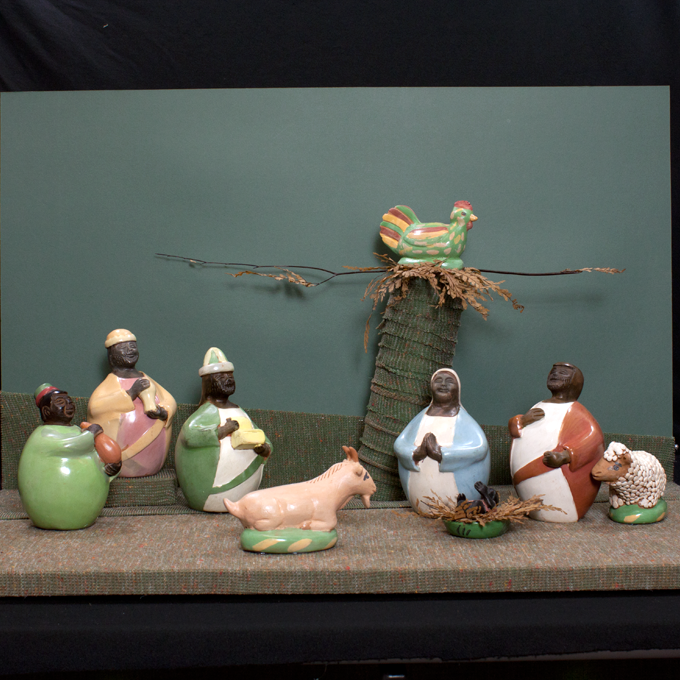
Gourd and Rooster
Angelica Silva
The village of Chulucanas in northern Peru produces its own brand of crafts, chulucanas art. The distinctive product or artifact are the charmingly rotund clay figures with their soft and satiny finish resulting from a firing process that uses smoldering mango leaves. The ancestor and model of these ample and portly figures is the gourd-like fruit of the calabash tree. Calabash shells, once used to represent human figures thanks to a carved little head added to the gourd, mutated over time to become the colorful and much sought-after clay sculptures like the ones in this nativity set. The prominently-featured rooster is a typical presence in Latin American nativity sets. It is a symbol of treason and reconciliation (Saint Peter) and, more generally, a harbinger of fertility.
– ML.1113.01
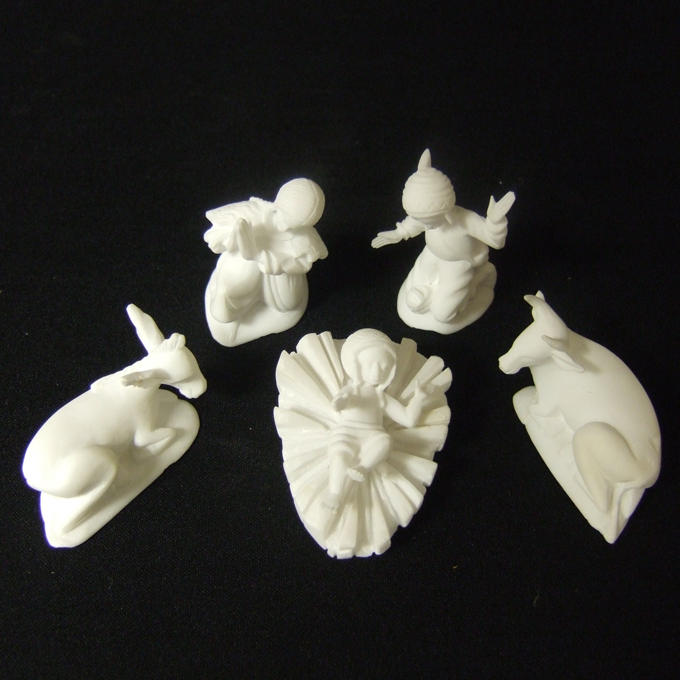
Carved in Stone
Unknown artist
From the land of rich and varied Christmas traditions, this work of exquisite quality is carved in the white stone of the Ayacucho area (Piedra de Huamanga). The whiteness of the stone and the graceful postures of the figures give this set weightlessness and transparency. The connoisseur of Peruvian crèche culture is used to heavier figures and darker colors from the Andes region. This set constitutes a welcome contrast in craftsmanship and meaning. Carved in stone does not necessarily mean monumental. Stone can be light and almost transparent. It is a symbol of weighty humanness made light and transparent by grace.
– ML.0164.04,06
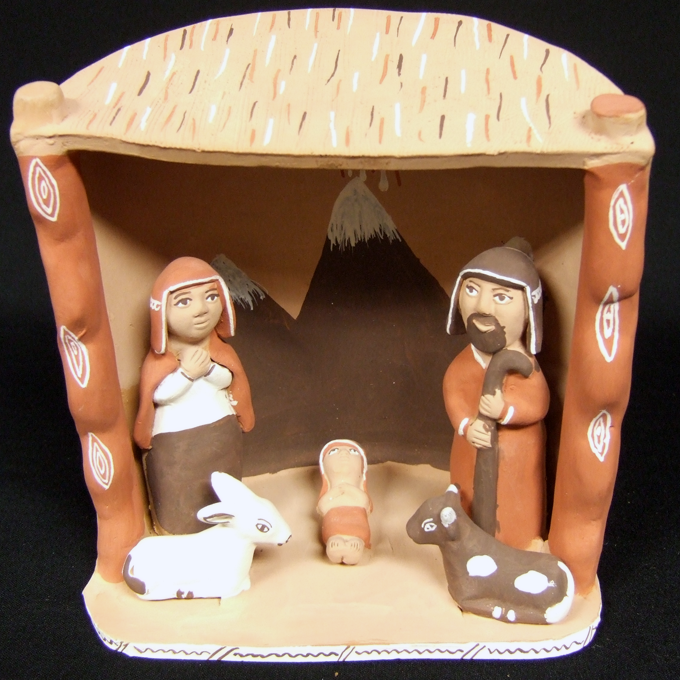
Taunting Heaven
Angelica Silva
If there was ever a mystery surrounding Christ's early dwelling among us, here it is disclosed and revealed. In terms of architecture, there is nothing left here but the bare bones. Calling this pergola housing would be a euphemism. The original meaning of pergola is that of a colonnade which supports an open roof of beams and poles. Here, the colonnade has dwindled to four poles only. Even Romulus and Remus had at least a solid roof over their heads; who else but the Son of God could be taunting heaven and getting away with it. The donkey seems to know. He is peacefully resting his tired limbs.
– ML.1119.18
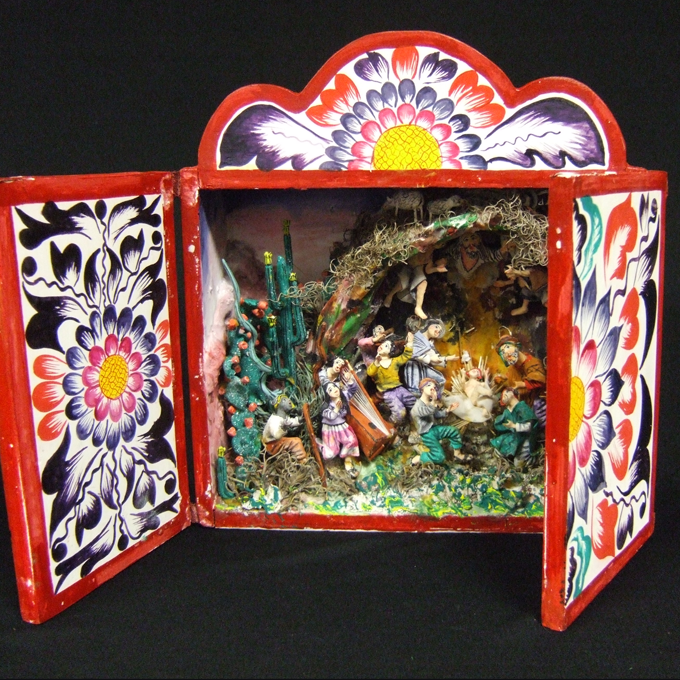
Portable Bliss
Huamani Mitma
All houses are receptacles of sort, but not all receptacles are houses. Another of the typical Peruvian representations comes in a painted box. Open during the season and on feastdays, it is also meant to be a traveling companion for people who need a portable altar. The expression of this nativity reenactment in painted plaster is one of pure bliss. A sea of hands is raised in praise of the Messiah, and musical instruments like harp, violin and castanet join in the joyous chorus. The baby with the red cap takes part in the general excitement, and even God Father has opened the curtain of heaven to become part of this portable bliss.
– ML.1119.06
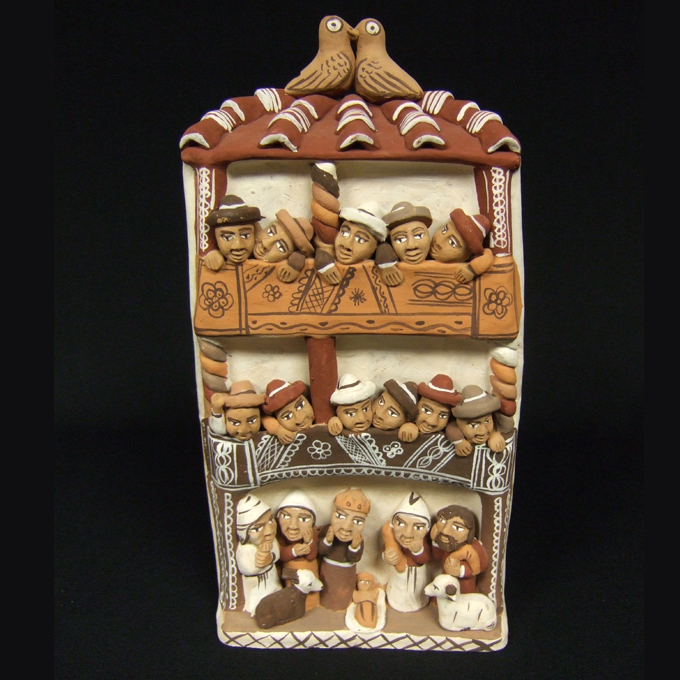
Spectacle for the Many
Unknown artist
This bas relief of a three-story house is of typical Andino provenance. Looking like a mixture of Stratford-on-Avon and fancy apartment house, it has two ornate balconies literally overflowing with spectators. Their rounded heads and merry hats are glued to the railing in an effort to see what is happening on the landing at the entrance of the house. There we discover an unusual nativity scene. The little figures surrounding the Christ child his parents and the wise men each hold a hand to their face in utter amazement of the spectacle which only the eyes of the heart can see. Here, Christ is still the object of a joyful spectacle. Thirty-three years later it will be a spectacle of derision.
– ML.0105.24
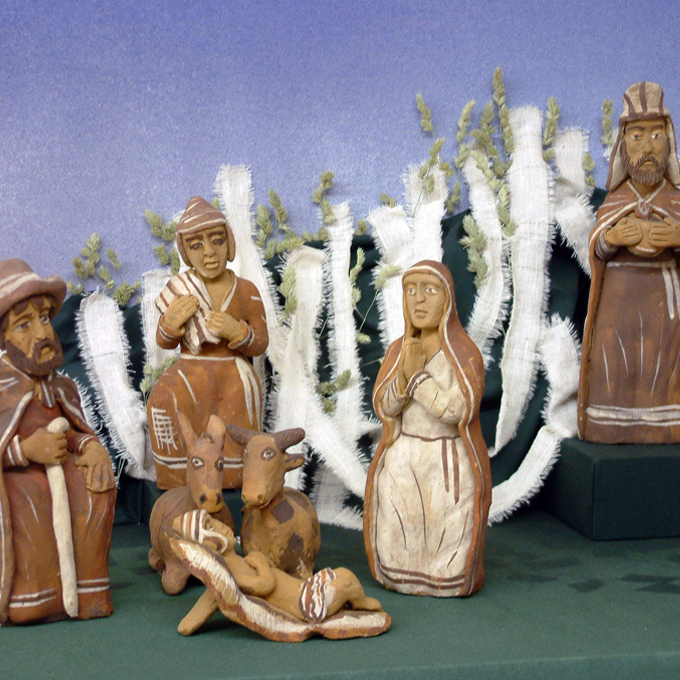
A Still, Small Voice
T. Acuna
The Andes are assimilated with high altitude, towering snow-capped mountains, and endless valleys. Over a period of thousands of years many civilizations have flourished, hidden on the flanks of this vast mountain range. Adapting to the unique environment, Andean people learned to freeze-dry food, practiced irrigation and terracing to cultivate the semi-arid highlands, and kept herds of llamas and alpacas for wool and textiles. No doubt influenced by the immensity and majesty of the natural habitat, the religion of the natives bears the marks of mystery and the unknown. Awe, endless devotion and patient expectation were the mountain people's answer to the challenge of the unknown and the appeal of the mystery. Some of these reactions can be read on the faces of the crèche people. Dressed for the altiplano, and painted in the subdued colors of earthen brown, black, and white, these figures convey great stillness and intense presence. The original Christmas was surely a matter of great stillness and intense presence. Christmas today is, hopefully, a "still, small voice."
– ML.2649
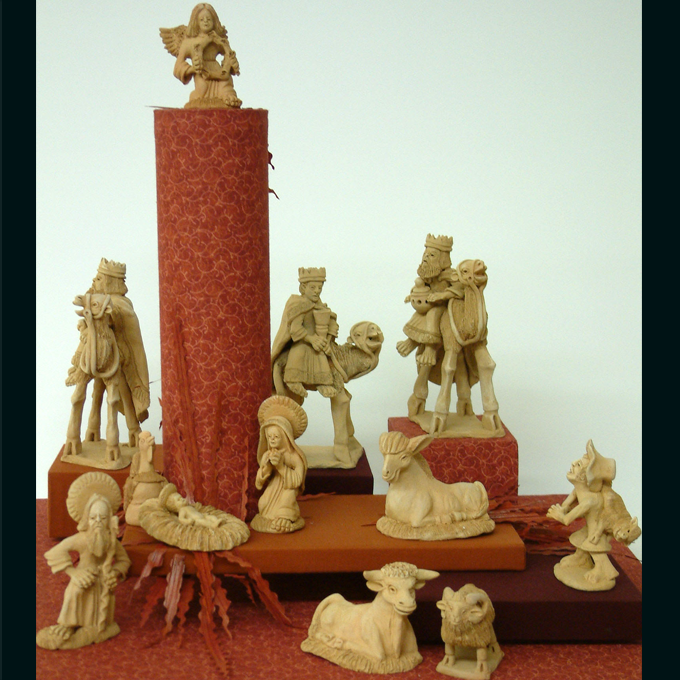
Hands and Feet
Inez Choque
This sturdy and earth-bound Nativity offers an overall impression of solid foundation and stability. The figures are little masterpieces escaping an amorphous and formless world of clay. But there is more. Take a closer look at their hands and feet. They are of disproportioned size and shape. They are huge and bony. In one word, they are impressive, and the true actors of the story played out in this set. See the intensity of Mary's prayer expressed in the huge folded hands; Saint Joseph, a giant hand on his hip, standing there like the guardian angel of paradise; the Magi-Kings sitting on sturdy, long-legged and broad-hooved camels, reigning in the animals with strong and massive fists. Even the tiny figure of the shepherd with the sizable sheep on his shoulder finds its most dramatic expression in the enormous hand ready and eager to present its gift to the baby. Hands and feet have their own language. In this set, it is a language of intense concentration and disciplined strength all directed toward the one who calls himself "Prince of Peace."
– ML-0106.28
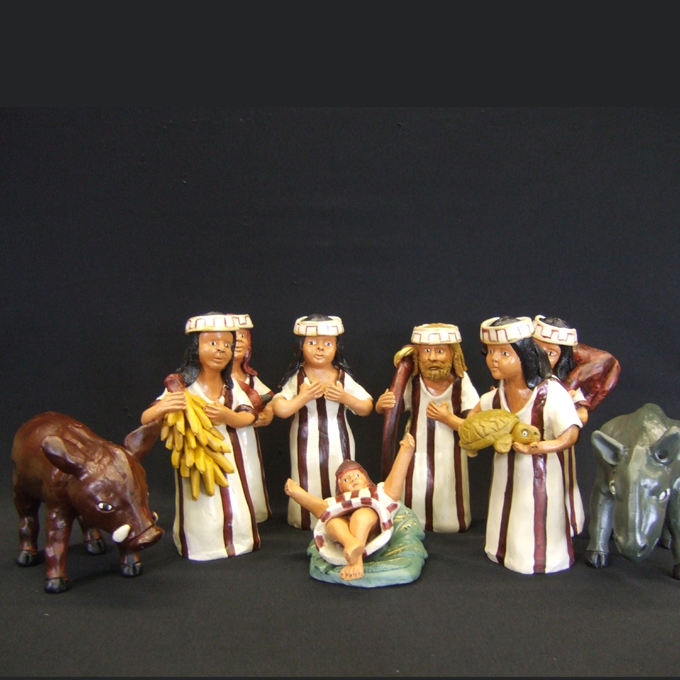
Amazon Christmas
Hilda Mamani Olivera
– ML.2168
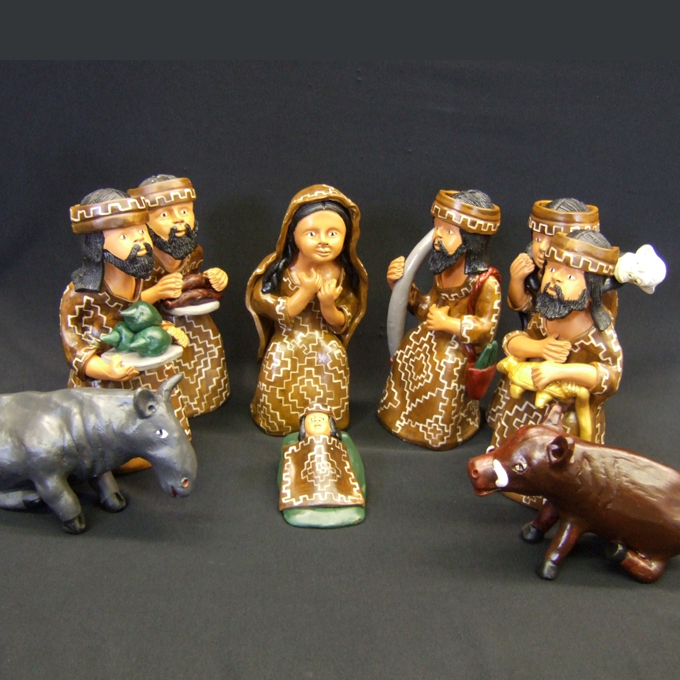
Among Wild Boar and Tapir
Hilda Mamani Olivera
The Shipibo tribe lives near the headwater of the Amazon in the Peruvian region of the Amazon. Of Panoan-speaking culture, the Shipibo are featured in traditional dress bringing rainforest gifts to the Christchild whose faithful companions are wild boar and tapir. Incarnation is building bridges to the remotest regions of the world.
– ML.2169
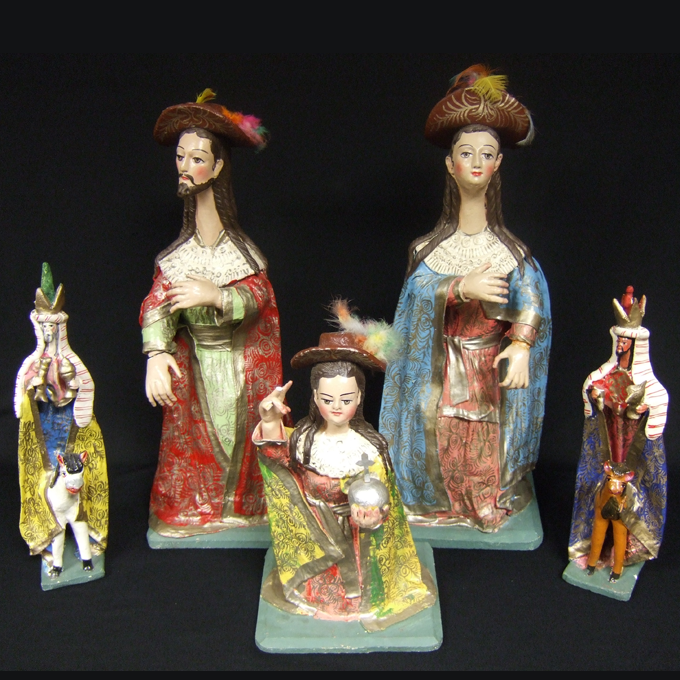
Mendívil Nativity [A Different Nativity]
Hilario Mendívil
Christmas is celebrated not only on December 25. A much older Christmas tradition identifies Christ's coming into this world with the feast of the Epiphany on January 6. On this day, proclaims theliturgical tradition, the Son of Man revealed himself to the world, the world now being everybody from near and far. Among those from far away regions were the three Magi Kings. It is thus without surprise that some cultures, especially Latin cultures, identify more radily with the "Reyes Magos," the Magi Kings. This is particularly true for Puerto Rico, where nativity sets may find their full expression in the sole representation of the Three Kings. They are on horseback equently riding a brown, white, and black horse, and holding gifts in one hand. The figures are wood carved and painted, and they contrast with the sumptuously painted paper mache kings of Cuzco (Peru) tradition of Hilario Mendivil and his school. The matter Magi Kings have long necks and are of proud bearing, dwarfing by the same token horse, camel, and elephant. In this set, patterned on the artistic tradition of the Spanish hidalgo or gentleman of the Golden period, the Christ Child of Atocha with the plumed hat asserts his authority as teacher and ruler over the wise men from the Orient.
– ML.2188
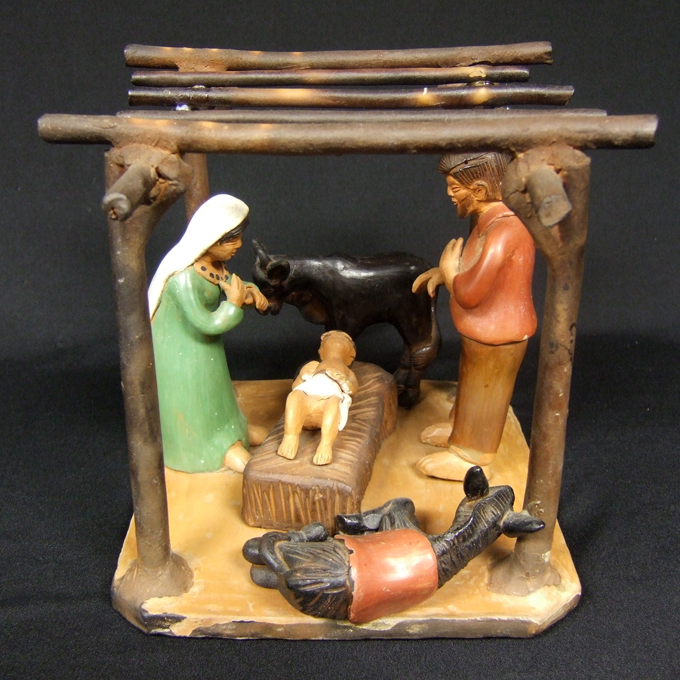
Taunting Heaven
Unknown artist
If there was ever a mystery surrounding Christ's early dwelling among us, here it is disclosed and revealed. In terms of architecture, there is nothing left here but the barenbones. Calling this pergola housing would be a euphemism. The original meaning of pergola is that of a colonnade which supports an open roof of beams and poles. Here, the colonnade has dwindled to four poles only. Even Romulus and Remus had at least a solid roof over their heads; who else but the Son of God could be taunting heaven and getting away with it. The donkey seems to know. He is peacefully resting his tired limbs.
– ML.1119.08
